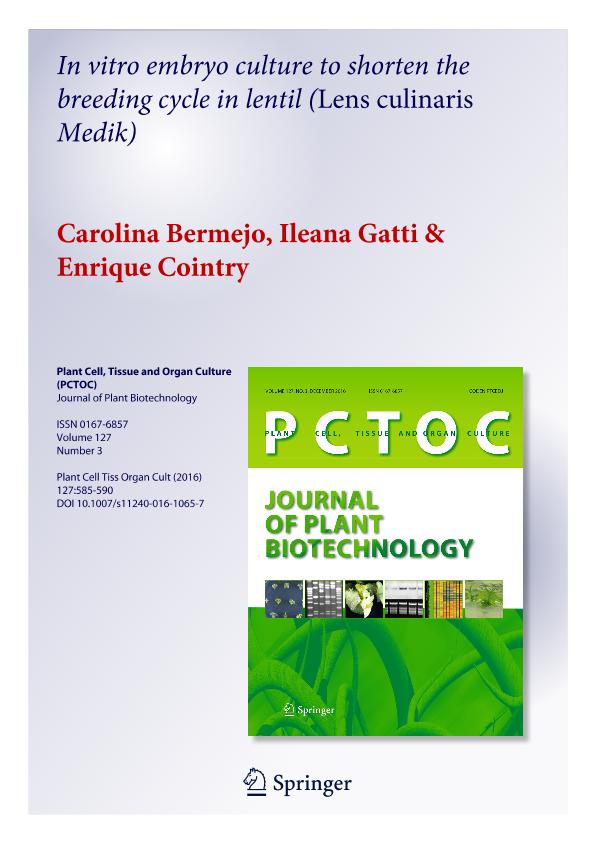Artículo
In vitro embryo culture to shorten the breeding cycle in lentil (Lens culinaris Medik)
Fecha de publicación:
12/2016
Editorial:
Springer
Revista:
Plant Cell, Tissue and Organ Culture
ISSN:
0167-6857
Idioma:
Inglés
Tipo de recurso:
Artículo publicado
Clasificación temática:
Resumen
Breeding in lentil involves hybridization followed by different selection methods and requires 10 years to obtain a cultivar, as only one field generation per year can be produced. To shorten the breeding time it is essential to use biotechnological methods such as in vitro embryo culture combined with SSD method since only one seed is enough to produce the next generation. An efficient in vitro–in vivo system was developed. The best time to extract immature embryos and the best culture medium to obtain their complete development were analyzed. Embryos of Pardina, B1181 (microsperma type), B1051 and A1145 (macrosperma type) were collected at 15, 18, 21, and 24 days after pollination (DAP) and cultured on MS medium with five different concentrations of 6-benzylaminopurine (BAP) (0–0.025–0.05–0.1–0.25 mg L−1). An ANOVA test among genotypes, media, DAP and their interactions was performed. Genotypes, DAP and its interaction showed significant effects on the percentage of shoot production (F = 61.8; F = 79.3; F = 8.5; p < 0.01) and germination (F = 70.7; F = 69.8; F = 3.9; p < 0.01). Medium effect was only significant for germination (F = 8.7; p < 0.01). The microsperma genotypes gave higher percentages of shoot production (>80 %) and germination (>70 %). Although in vitro culture efficiency increased with DAP, 18 DAP was selected due to its high percentages of germination (13–70 %). The medium without BAP was the most suitable for embryo complete development (41–87 %). All plants obtained were morphologically normal and fertile. Using this approach, four generations per year were obtained allowing a rapid development of RILs.
Palabras clave:
Immature Seeds
,
In Vitro Culture
,
Lentil
,
Short Generation Cycles
Archivos asociados
Licencia
Identificadores
Colecciones
Articulos(CCT - ROSARIO)
Articulos de CTRO.CIENTIFICO TECNOL.CONICET - ROSARIO
Articulos de CTRO.CIENTIFICO TECNOL.CONICET - ROSARIO
Citación
Bermejo, Carolina Julieta; Gatti, Ileana; Cointry Peix, Enrique Luis; In vitro embryo culture to shorten the breeding cycle in lentil (Lens culinaris Medik); Springer; Plant Cell, Tissue and Organ Culture; 127; 3; 12-2016; 585-590
Compartir
Altmétricas




